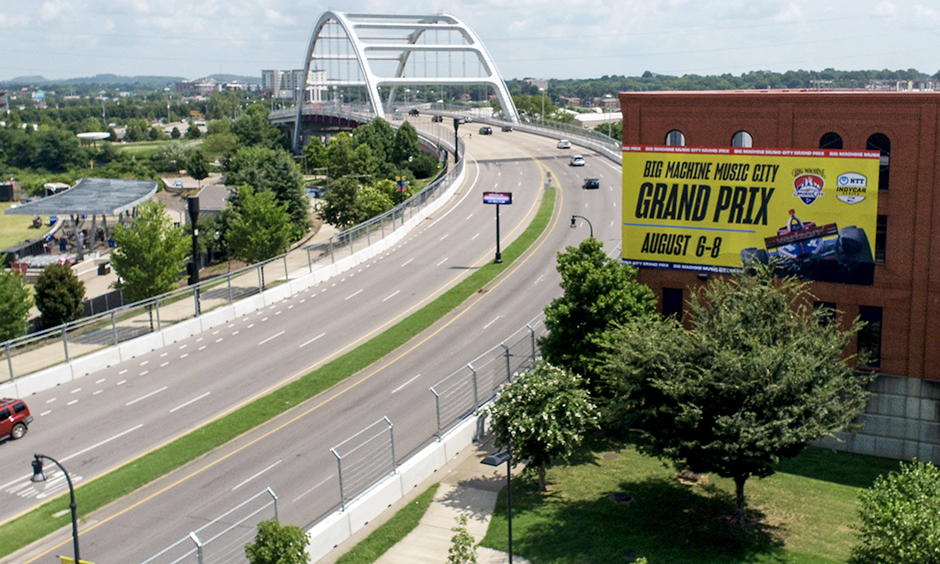An Insiders’ Look at New Nashville Street Circuit
JUL 30, 2021
The track build for the inaugural Big Machine Music City Grand Prix, the first new temporary street course circuit on the NTT INDYCAR SERIES schedule in a decade, is taking shape for the highly anticipated Aug. 6-8 motorsports weekend in downtown Nashville.
Nearly 75 percent of the 2,000 12-foot sections of a brand-new barrier and fencing modular system are in place on the 2.17-mile layout as work continues this week between 8 p.m.-5 a.m. on the 18-day, Sunday-through-Thursday construction calendar. The state-of-the-art, energy-absorbing system, which meets all the most recent FIA testing requirements, will line the layout that includes the Korean War Veterans Memorial Bridge and the campus of Nissan Stadium.
The coming days also will include continued improvements such as grinding transitions, adding new expansion joints to the bridge, erecting crossover bridges and releveling manhole covers before they are welded shut during race week. Other significant prior work on the layout included a complete repave for the pit lane area, including entry and exit, as well as creating concrete pit boxes to accommodate up to 30 cars if needed.
The Big Machine Music City Grand Prix is among four temporary street circuit venues on the 2021 schedule - joining St. Petersburg, Detroit and Long Beach – but will be the NTT INDYCAR SERIES’ first new temporary street course event since 2011 when the Grand Prix of Baltimore made its debut. The layout and build are being spearheaded by NZR Consulting Principal Tony Cotman, a veteran track designer and builder of temporary street courses.
The signature segment of the 11-turn layout will be the cars racing across the Korean War Veterans Memorial Bridge, which stretches across the Cumberland River and connects East Nashville with downtown.
“While running over a bridge may be different or new, at the end of the day you are just purely building a racetrack,” Cotman said. “In this situation, the track goes down one side (of the bridge) and then the other, and it will certainly showcase the city of Nashville well. When you see that bridge, you will know where this race is from anywhere in the world.”
So how did Nashville’s iconic bridge wind up in the downtown layout? The proposed course was established from the outset that the Tennessee Titans and Nissan Stadium were going to be vital partners in this event coming to fruition.
“Early on, we were aware that a significant portion of the track was going to involve the Titans’ stadium, not only the track but pit lane as well since there were not a lot of areas that could handle that footprint,” Cotman said. “So, we started on the Titans’ side of the river and branched out looking for straights and the bridge came into play due to the lengths of the straightaways. They are about 3,400 to 3,500 feet in length, which is equivalent to the frontstretch at Indianapolis Motor Speedway.”
The bridge also could present passing opportunities for drivers.
“If a driver gets a better corner exit than another, you will be able to overtake them especially with the width of the track over the bridge,” Cotman said. “Forty feet is the typical width of a racetrack, and we are 40 feet wide on each side.”
However, the prime passing opportunities, according to Cotman, may be Turns 4, 9 and 10, the latter two being left-handers after coming off the bridge straightway.
“That first corner (9) coming off the bridge is as wide as Cleveland and fast with a massive run-off area, so drivers will be enticed, especially with multiple lines into the corner,” said Cotman, referring to the old street circuit that was run on the expansive runways of Burke Lakefront Airport. “Then you have a straightaway from Turn 9 heading into Turn 10 that could be another location for overtaking.”
One of the aspects that Cotman relishes about this layout is the spectator viewing from various grandstands.
“You can’t get away from the uniqueness of the bridge and what it brings,” Cotman said. “Two of the high points are when you see the bridge you know exactly where the race is, and number two is the viewing locations coming off that bridge. Due to the shape of the street and width as well as the barrier locations, there are some great viewing opportunities coming off the bridge.
“Overall, you can see a lot of action from different grandstands, and we really want to put on a good show for the fans. With this being a new event and the teams have no data to fall back on usually makes for a good event.”
On-track action begins Friday, Aug. 6, including the opening NTT INDYCAR SERIES practice at 4:10 p.m. (ET). The weekend culminates Sunday, Aug. 8, with the running of the 80-lap Big Machine Music City Grand Prix NTT INDYCAR SERIES race beginning at 5:30 p.m. (NBCSN).
For more information on the Big Machine Music City Grand Prix, visit musiccitygp.com or follow us on Facebook, Instagram and Twitter at @musiccitygp. Limited single-day grandstand tickets, general admission tickets and festival add-ons are available at musiccitygp.com/tickets, Ticketmaster.com or by calling the Tennessee Titans’ ticket office at 615-565-4650.
























